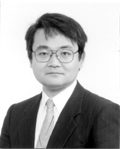

|
Hironobu TakahashiTRC Active
Intelligence
Laboratory |
Profile
| Affiliation:
| Active Intelligence Laboratory, Theory and Novel Functions Department,
Tsukuba Research Center |
| Birth date:
| December 17, 1958 |
| Birthplace:
| Miyagi |
| Background:
| |
| 1982
| Graduated from the Faculty of Science, Kyoto University |
| 1984
| Completed the masterケs course of biophysics, Graduate School of
Science, Kyoto University |
| 1985
| Joined Sanyo Electric Co., Ltd. |
| 1993
| On loan to the Real World Computing
Partnership |
I was born in Miyagi, a north-eastern prefecture on Honshu Island. Attracted
by the Kansai Area in the western part of the main island including Osaka and
Kyoto, I went down to the area and spent seven years in Kyoto, an ancient
capital of Japan. When I went to university in Kyoto, I was ambitious to be a
world-famous scientist and find a "better half." It is traditionally believed in
Japan that a man from eastern Japan and a woman from western Japan make a very
good couple. A few days after I entered the university, I abandoned my first
ambition to be an internationally renowned scientist because I met many people
far better than I. But I achieved my second goal by finding my wife. Half
success and half failure.
I joined Sanyo in 1985 when the company was looking for staff for their
newly-built research center in Tsukuba. Since then, I have been in this rural
academic city for 11 years. In 1985 when I came here, I found the city of
Tsukuba very attractive because it had a number of research institutes and a
World Science Exposition was being held then.
Maybe because I was born and raised in a rural place, I feel comfortable in
this open city and prefer it to the crowded urban areas like Kyoto where houses
are jammed together with just a few inches' clearance. In Tsukuba, the streets
are wide and there are many places where children can freely play. I'd like to
believe that's the reason I had a fourth child last year.
I often spend my private time computer-hacking. In 1986, I was on loan to the
Electrotechnical Laboratory for a computer vision study. My assignment to the
institute coincided with the arrival of JUNET. I still remember that I was very
impressed by the volunteer network as it covered the entire world.
During the mid 1980s, we had to use every trick we knew in order to run in
Japanese environments the English applications and tools delivered by Usenet and
Internet. So, I tried to localize Internet tools into Japanese as a volunteer
and for pleasure.
Also, I created a utility software named "kakasi" as we needed to convert
Japanese sentences with a mixture of kanji, katakana and hiragana into
hiragana-only or alphabet-only sentences on network. It is not a sophisticated
algorithm and would make Japanese processing experts mad. Yet, it is widely used
for many purposes including the conversion of Japanese sentences into Roman
alphabet or "romaji" for non-Japanese speakers and the creation of dictionaries
with entries listed in the order of their pronunciation. You will find "kakasi"
in the TRC environment as well.
When I was a university student, I majored in the physiology of the eye. But
I spent most of my time in the computer room saying "this is an experiment." I
decided to join the electric manufacturer as a computer vision researcher
because I thought it would be possible to get involved both in the study of eye
physiology and computer there.
When I started my career, researchers were trying to reproduce the ability of
human sight by computer as part of artificial intelligence research as
exemplified by "Vision," Marr's posthumous work. Image processing and the range
finder had already been in wide use and were to be found in industrial
applications. However, researchers were eagerly pursuing cognition methods and
systems much closer to the human sense. That is why I have been continuously
involved in research activities based on stereo vision. Once completed, I
believe it will contribute to the development of artificial intelligence and
intelligent robots in the research field and offer a number of industrial
applications.
Stereo vision was almost blind ten years ago. Now I can use the resources of
the RWCP as a member of the partnership, and this system can find and recognize
a target on a desk in 10 seconds once an appropriate model is given. I also
developed in cooperation with Dr. Suehiro, chief of the TRC Active Intelligence
Laboratory, a system which can pursue in real-time an object by using its stereo
sight.
At present, I am responsible for developing the cognitive capability of an
agent network and am engaged in assembly work. It will be completed by the end
of this year or soon after the beginning of next year.

